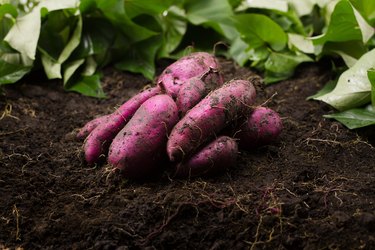
Whether they are featured on the Thanksgiving table, baked into a pie or wrapped in tinfoil and grilled during the warm summer months, sweet potatoes are a kitchen staple regardless of the time of year. However, just like any other vegetable, you may notice some irregularities during preparation, such as white spots on the sweet potato.
White Spots on a Sweet Potato
Video of the Day
White specks in sweet potatoes do not mean that the sweet potato has gone bad. What you are seeing is liquid starch. You might have even noticed the sweet potato leak the white liquid starch when you cut into it. This is entirely normal, and the liquid starch is a mixture of sugar and starch that is not limited to just sweet potatoes. You may notice it when cutting into squash as well.
Video of the Day
Depending on how you cut the potato, you may see the liquid starch as white spots in the sweet potato or in its liquid form. Regardless, it's no cause for alarm, and the liquid can easily be washed away with water if you wish. Once cooked, the liquid starch will be undetectable.
Sweet potatoes can gain white spots around the center when stored in the refrigerator. This is not an indicator of rot, however, just improper storage. Sweet potatoes are best kept out of the refrigerator since refrigeration can affect their taste.
How to Store Sweet Potatoes
Uncooked sweet potatoes should be stored in a cool, dry and well-ventilated place, much like you would with an Idaho or Yukon potato. When properly stored, sweet potatoes can last for up to two weeks.
However, they should never be stored in the refrigerator uncooked. When kept in the refrigerator or in similar cold conditions, they can develop a hard center that will taste "off" or unpleasant when eaten. If storing in the refrigerator is necessary or if you wish to freeze them, cook the sweet potatoes first. Start by washing and peeling the sweet potatoes and then boil them until tender. Then, slice or mash the potatoes depending on your preference and drizzle them with a little lemon juice. This will help preserve the color.
Make sure the sweet potatoes cool completely before storing them in an airtight container or freezer bag before freezing. Sweet potatoes can last up to a year when frozen.
How to Tell When a Sweet Potato Goes Bad
It's common for sweet potatoes to have dark spots on their skin, and this does not necessarily indicate that the potato has gone bad. However, take a closer look at the spots. Mold on sweet potatoes can be difficult to distinguish if it is caught early enough, but if any discolored spots have a fuzzy quality, you have found mold. By this point, the sweet potato should not be eaten.
Soft spots are also an indication that the sweet potato has gone bad. Sweet potatoes are supposed to be firm, so if you can easily press your thumb into the potato, it's time to discard it. These soft spots can also appear wet, so if you notice a soft sweet potato in a bag of ripe sweet potatoes, be sure to wipe dry the unspoiled sweet potatoes before returning them to storage. Moisture can easily lead to mold if left to sit over time.
Another common indicator is dry spots. Over time, sweet potatoes will dry out, making their skin turn gray and wrinkly. If your sweet potatoes look as if they are shriveling, they have gone bad.